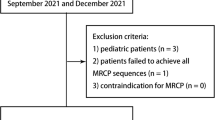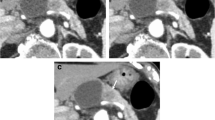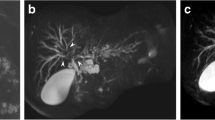Abstract
Objectives
To evaluate the image quality of the 3D hybrid profile order technique and deep-learning-based reconstruction (DLR) for 3D magnetic resonance cholangiopancreatography (MRCP) within a single breath-hold (BH) at 3 T magnetic resonance imaging (MRI).
Methods
This retrospective study included 32 patients with biliary and pancreatic disorders. BH images were reconstructed with and without DLR. The signal-to-noise ratio (SNR), contrast, contrast-to-noise ratio (CNR) between the common bile duct (CBD) and periductal tissues, and full width at half maximum (FWHM) of CBD on 3D-MRCP were evaluated quantitatively. Two radiologists scored image noise, contrast, artifacts, blur, and overall image quality of the three image types using a 4-point scale. Quantitative and qualitative scores were compared using the Friedman test and post hoc Nemenyi test.
Results
The SNR and CNR were not significantly different when under respiratory gating- and BH-MRCP without DLR. However, they were significantly higher under BH with DLR than under respiratory gating (SNR, p = 0.013; CNR, p = 0.027). The contrast and FWHM of MRCP under BH with and without DLR were lower than those under respiratory gating (contrast, p < 0.001; FWHM, p = 0.015). Qualitative scores for noise, blur, and overall image quality were higher under BH with DLR than those under respiratory gating (blur, p = 0.003; overall, p = 0.008).
Conclusions
The combination of the 3D hybrid profile order technique and DLR is useful for MRCP within a single BH and does not lead to the deterioration of image quality and space resolution at 3 T MRI.
Clinical relevance statement
Considering its advantages, this sequence might become the standard protocol for MRCP in clinical practice, at least at 3.0 T.
Key Points
• The 3D hybrid profile order can achieve MRCP within a single breath-hold without a decrease in spatial resolution.
• The DLR significantly improved the CNR and SNR of BH-MRCP.
• The 3D hybrid profile order technique with DLR reduces the deterioration of image quality in MRCP within a single breath-hold.






Similar content being viewed by others
Data availability
The datasets generated or analyzed during the study are available from the corresponding author upon reasonable request.
Change history
30 June 2023
A minor typographical error in the article title has been corrected.
Abbreviations
- BH:
-
Breath-hold
- CNR:
-
Contrast-to-noise ratio
- DLR:
-
Deep-learning-based reconstruction
- FWHM:
-
Full-width at half maximum
- MRCP:
-
Magnetic resonance cholangiopancreatography
- ROI:
-
Regions of interest
- SI:
-
Signal intensity
- SNR:
-
Signal-to-noise ratio
- TSE:
-
Turbo spin-echo
References
Taylor AC, Little AF, Hennessy OF, Banting SW, Smith PJ, Desmond PV (2002) Prospective assessment of magnetic resonance cholangiopancreatography for noninvasive imaging of the biliary tree. Gastrointest Endosc 55:17–22
Limanond P, Raman SS, Ghobrial RM, Busuttil RW, Lu DS (2004) The utility of MRCP in preoperative mapping of biliary anatomy in adult-to-adult living related liver transplant donors. J Magn Reson Imaging 19:209–215
Morita S, Ueno E, Suzuki K et al (2008) Navigator-triggered prospective acquisition correction (PACE) technique vs. conventional respiratory-triggered technique for free-breathing 3D MRCP: an initial prospective comparative study using healthy volunteers. J Magn Reson Imaging 28:673–677
Zhang J, Israel GM, Hecht EM, Krinsky GA, Babb JS, Lee VS (2006) Isotropic 3D T2-weighted MR cholangiopancreatography with parallel imaging: feasibility study. AJR Am J Roentgenol 187:1564–1570
Weigel M, Hennig J (2006) Contrast behavior and relaxation effects of conventional and hyperecho-turbo spin echo sequences at 1.5 and 3 T. Magn Reson Med 55:826–835
Yokoyama K, Nakaura T, Iyama Y et al (2016) Usefulness of 3D hybrid profile order technique with 3T magnetic resonance cholangiography: Comparison of image quality and acquisition time. J Magn Reson Imaging 44:1346–1353
Chu ML, Chien CP, Wu WC, Chung HW (2019) Gradient- and spin-echo (GRASE) MR imaging: a long-existing technology that may find wide applications in modern era. Quant Imaging Med Surg 9:1477–1484
Hirata K, Nakaura T, Okuaki T et al (2018) 3D hybrid profile order technique in a single breath-hold 3D T2-weighted fast spin-echo sequence: usefulness in diagnosis of small liver lesions. Eur J Radiol 98:113–117
Yoshida M, Nakaura T, Inoue T et al (2018) Magnetic resonance cholangiopancreatography with GRASE sequence at 3.0T: does it improve image quality and acquisition time as compared with 3D TSE? Eur Radiol 28:2436–2443
Uetani H, Nakaura T, Kitajima M et al (2021) A preliminary study of deep learning-based reconstruction specialized for denoising in high-frequency domain: usefulness in high-resolution three-dimensional magnetic resonance cisternography of the cerebellopontine angle. Neuroradiology 63:63–71
Kim M, Kim HS, Kim HJ et al (2021) Thin-slice pituitary MRI with deep learning-based reconstruction: diagnostic performance in a postoperative setting. Radiology 298:114–122
Wang X, Ma J, Bhosale P et al (2021) Novel deep learning-based noise reduction technique for prostate magnetic resonance imaging. Abdom Radiol (NY) 46:3378–3386
Tajima T, Akai H, Sugawara H et al (2021) Breath-hold 3D magnetic resonance cholangiopancreatography at 1.5 T using a deep learning-based noise-reduction approach: Comparison with the conventional respiratory-triggered technique. Eur J Radiol 144:109994
Mugler JP 3rd (2014) Optimized three-dimensional fast-spin-echo MRI. J Magn Reson Imaging 39:745–767
Kidoh M, Shinoda K, Kitajima M et al (2020) Deep learning based noise reduction for brain mr imaging: tests on phantoms and healthy volunteers. Magn Reson Med Sci 19:195–206
Deshmane A, Gulani V, Griswold MA, Seiberlich N (2012) Parallel MR imaging. J Magn Reson Imaging 36:55–72
Willinek WA, Gieseke J, von Falkenhausen M, Neuen B, Schild HH, Kuhl CK (2003) Sensitivity encoding for fast MR imaging of the brain in patients with stroke. Radiology 228:669–675
Chen Z, Sun B, Xue Y et al (2021) Comparing compressed sensing breath-hold 3D MR cholangiopancreatography with two parallel imaging MRCP strategies in main pancreatic duct and common bile duct. Eur J Radiol 142:109833
Nakaura T, Kidoh M, Maruyama N et al (2013) Usefulness of the SPACE pulse sequence at 1.5T MR cholangiography: comparison of image quality and image acquisition time with conventional 3D-TSE sequence. J Magn Reson Imaging 38:1014–1019
Yoshikawa T, Mitchell DG, Hirota S et al (2006) Focal liver lesions: breathhold gradient- and spin-echo T2-weighted imaging for detection and characterization. J Magn Reson Imaging 23:520–528
Jung G, Krahe T, Kugel H et al (1997) Prospective comparison of fast SE and GRASE sequences and echo planar imaging with conventional SE sequences in the detection of focal liver lesions at 1.0 T. J Comput Assist Tomogr 21:341–347
Mezrich R (1995) A perspective on K-space. Radiology 195:297–315
Caparelli EC, Tomasi D (2008) K-space spatial low-pass filters can increase signal loss artifacts in Echo-Planar Imaging. Biomed Signal Process Control 3:107–114
Moratal D, Valles-Luch A, Marti-Bonmati L, Brummer M (2008) k-Space tutorial: an MRI educational tool for a better understanding of k-space. Biomed Imaging Interv J 4:e15
Tokoro H, Yamada A, Suzuki T et al (2020) Usefulness of breath-hold compressed sensing accelerated three-dimensional magnetic resonance cholangiopancreatography (MRCP) added to respiratory-gating conventional MRCP. Eur J Radiol 122:108765
Lohofer FK, Kaissis GA, Rasper M et al (2019) Magnetic resonance cholangiopancreatography at 3 Tesla: image quality comparison between 3D compressed sensing and 2D single-shot acquisitions. Eur J Radiol 115:53–58
Acknowledgements
We thank Ms. Tae Hamakawa from the Department of Diagnostic Radiology, Kumamoto University, Japan, for her help with the measuring in the quantitative analysis.
Funding
The authors state that this work has not received any funding.
Author information
Authors and Affiliations
Corresponding author
Ethics declarations
Guarantor
The scientific guarantor of this publication is Toshinori Hirai.
Conflict of interest
Takeshi Nakaura has received research support from Nemoto Kyorindo Co., Ltd. Toshinori Hirai has received research support from Canon Medical Systems. The department of diagnostic imaging analysis, to which Dr. Kidoh belongs, is an endowed chair supported by Philips Healthcare. The Nemoto Kyorindo Co., Ltd., Philips Healthcare, and Canon Medical Systems had no control over the interpretation, writing, or publication of this work.
Statistics and biometry
No complex statistical methods were necessary for this paper.
Informed consent
Informed consent was waived by Institutional Review Board.
Ethical approval
Institutional Review Board approval was obtained.
Study subjects or cohorts overlap
Some study subjects or cohorts have not been previously reported.
Methodology
• Retrospective
• Observational
• performed at one institution
Additional information
Publisher's note
Springer Nature remains neutral with regard to jurisdictional claims in published maps and institutional affiliations.
Rights and permissions
Springer Nature or its licensor (e.g. a society or other partner) holds exclusive rights to this article under a publishing agreement with the author(s) or other rightsholder(s); author self-archiving of the accepted manuscript version of this article is solely governed by the terms of such publishing agreement and applicable law.
About this article
Cite this article
Shiraishi, K., Nakaura, T., Uetani, H. et al. Deep learning–based reconstruction and 3D hybrid profile order technique for MRCP at 3T: evaluation of image quality and acquisition time. Eur Radiol 33, 7585–7594 (2023). https://doi.org/10.1007/s00330-023-09703-z
Received:
Revised:
Accepted:
Published:
Issue Date:
DOI: https://doi.org/10.1007/s00330-023-09703-z




